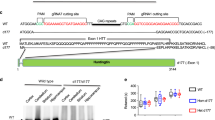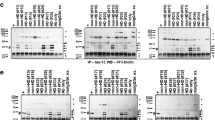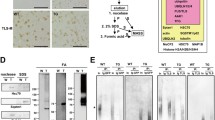Abstract
Accumulating evidence highlights the potential role of mixed proteinopathies (i.e., abnormal protein aggregation) in the development of clinical manifestations of neurodegenerative diseases (NDD). Huntington’s disease (HD) is an inherited NDD caused by autosomal-dominant expanded CAG trinucleotide repeat mutation in the gene coding for Huntingtin (Htt). Previous studies have suggested the coexistence of phosphorylated-Tau, α-synuclein (α-Syn) and TAR DNA-binding protein 43 (TDP-43) inclusions in HD. However, definite evidence that HD pathology in humans can be accompanied by other proteinopathies is still lacking. Using human post-mortem putamen samples from 31 controls and 56 HD individuals, we performed biochemical analyses of the expression, oligomerization and aggregation of Tau, α-Syn, TDP-43, and Amyloid precursor protein (APP)/Aβ. In HD brain, we observed reduced soluble protein (but not mRNA) levels of Htt, α-Syn, and Tau. Our results also support abnormal phosphorylation of Tau in more advanced stages of disease. Aberrant splicing of Tau exons 2, 3 (exclusion) and 10 (inclusion) was also detected in HD patients, leading to higher 0N4R and lower 1N3R isoforms. Finally, following formic acid extraction, we observed increased aggregation of TDP-43, α-Syn, and phosphorylated-Tau during HD progression. Notably, we observed that 88% of HD patients with Vonsattel grade 4 neuropathology displayed at least one non-Htt proteinopathy compared to 29% in controls. Interestingly, α-Syn aggregation correlated with Htt, TDP-43 and phosphorylated-Tau in HD but not in controls. The impact of this work is twofold: (1) it provides compelling evidences that Tau, α-Syn and TDP-43 proteinopathies are increased in HD, and (2) it suggests the involvement of common mechanisms leading to abnormal accumulation of aggregation-prone proteins in NDD. Further studies will be needed to decipher the impact of these proteinopathies on clinical manifestation of HD.







Similar content being viewed by others
References
Arai T, Mackenzie IR, Hasegawa M et al (2009) Phosphorylated TDP-43 in Alzheimer’s disease and dementia with Lewy bodies. Acta Neuropathol 117:125–136. https://doi.org/10.1007/s00401-008-0480-1
Aronin N, Chase K, Young C et al (1995) CAG expansion affects the expression of mutant Huntingtin in the Huntington’s disease brain. Neuron 15:1193–1201
Blum D, Herrera F, Francelle L et al (2015) Mutant huntingtin alters Tau phosphorylation and subcellular distribution. Hum Mol Genet 24:76–85. https://doi.org/10.1093/hmg/ddu421
Braisch U, Hay B, Muche R et al (2017) Identification of extreme motor phenotypes in Huntington’s disease. Am J Med Genet B Neuropsychiatr Genet 174:283–294. https://doi.org/10.1002/ajmg.b.32514
Buée L, Bussière T, Buée-Scherrer V et al (2000) Tau protein isoforms, phosphorylation and role in neurodegenerative disorders. Brain Res Brain Res Rev 33:95–130
Caillet-Boudin ML, Buée L, Sergeant N, Lefebvre B (2015) Regulation of human MAPT gene expression. Mol Neurodegener 10:28. https://doi.org/10.1186/s13024-015-0025-8
Charles V, Mezey E, Reddy PH et al (2000) Alpha-synuclein immunoreactivity of huntingtin polyglutamine aggregates in striatum and cortex of Huntington’s disease patients and transgenic mouse models. Neurosci Lett 289:29–32
Conrad C, Zhu J, Conrad C et al (2007) Single molecule profiling of tau gene expression in Alzheimer’s disease. J Neurochem 103:1228–1236. https://doi.org/10.1111/j.1471-4159.2007.04857.x
Corrochano S, Renna M, Carter S et al (2012) α-Synuclein levels modulate Huntington’s disease in mice. Hum Mol Genet 21:485–494. https://doi.org/10.1093/hmg/ddr477
Cubillos-Rojas M, Amair-Pinedo F, Tato I et al (2010) Simultaneous electrophoretic analysis of proteins of very high and low molecular mass using Tris-acetate polyacrylamide gels. Electrophoresis 31:1318–1321. https://doi.org/10.1002/elps.200900657
Davis MY, Keene CD, Jayadev S et al (2014) The co-occurrence of Alzheimer’s disease and Huntington’s disease: a neuropathological study of 15 elderly Huntington’s disease subjects. J Huntingtons Dis 3:209–217. https://doi.org/10.3233/JHD-140111
DiFiglia M, Sapp E, Chase KO et al (1997) Aggregation of huntingtin in neuronal intranuclear inclusions and dystrophic neurites in brain. Science 277:1990–1993
Edmonds EC, Bangen KJ, Delano-Wood L et al (2016) Patterns of cortical and subcortical amyloid burden across stages of preclinical Alzheimer’s disease. J Int Neuropsychol Soc 22:978–990. https://doi.org/10.1017/S1355617716000928
Elobeid A, Libard S, Leino M et al (2016) Altered proteins in the aging brain. J Neuropathol Exp Neurol 75:316–325. https://doi.org/10.1093/jnen/nlw002
Fernandez-Nogales M, Cabrera JR, Santos-Galindo M et al (2014) Huntington’s disease is a four-repeat tauopathy with tau nuclear rods. Nat Med 20:881–885. https://doi.org/10.1038/nm.3617
Fourie C, Kim E, Waldvogel H et al (2014) Differential changes in postsynaptic density proteins in postmortem Huntington’s disease and Parkinson’s disease human brains. J Neurodegener Dis 2014:938530. https://doi.org/10.1155/2014/938530
Golde TE, Borchelt DR, Giasson BI et al (2013) Thinking laterally about neurodegenerative proteinopathies. J Clin Invest 123:1847–1855. https://doi.org/10.1172/JCI66029
Gratuze M, Cisbani G, Cicchetti F et al (2016) Is Huntington’s disease a tauopathy. Brain 139:1014–1025. https://doi.org/10.1093/brain/aww021
Gratuze M, Noël A, Julien C et al (2015) Tau hyperphosphorylation and deregulation of calcineurin in mouse models of Huntington’s disease. Hum Mol Genet 24:86–99. https://doi.org/10.1093/hmg/ddu456
Greenberg SG, Davies P (1990) A preparation of Alzheimer paired helical filaments that displays distinct tau proteins by polyacrylamide gel electrophoresis. Proc Natl Acad Sci USA 87:5827–5831
Hensman Moss DJ, Flower MD, Lo KK et al (2017) Huntington’s disease blood and brain show a common gene expression pattern and share an immune signature with Alzheimer’s disease. Sci Rep 7:44849. https://doi.org/10.1038/srep44849
Hernandez-Rapp J, Rainone S, Goupil C et al (2016) microRNA-132/212 deficiency enhances Aβ production and senile plaque deposition in Alzheimer’s disease triple transgenic mice. Sci Rep 6:30953. https://doi.org/10.1038/srep30953
Hodges A, Strand AD, Aragaki AK et al (2006) Regional and cellular gene expression changes in human Huntington’s disease brain. Hum Mol Genet 15:965–977. https://doi.org/10.1093/hmg/ddl013
Hoffner G, Djian P (2014) Monomeric, oligomeric and polymeric proteins in huntington disease and other diseases of polyglutamine expansion. Brain Sci 4:91–122. https://doi.org/10.3390/brainsci4010091
Hoffner G, Island ML, Djian P (2005) Purification of neuronal inclusions of patients with Huntington’s disease reveals a broad range of N-terminal fragments of expanded huntingtin and insoluble polymers. J Neurochem 95:125–136. https://doi.org/10.1111/j.1471-4159.2005.03348.x
Hosokawa M, Kondo H, Serrano GE et al (2017) Accumulation of multiple neurodegenerative disease-related proteins in familial frontotemporal lobar degeneration associated with granulin mutation. Sci Rep 7:1513. https://doi.org/10.1038/s41598-017-01587-6
Jacobs M, Hart EP, van Zwet EW et al (2016) Progression of motor subtypes in Huntington’s disease: a 6-year follow-up study. J Neurol 263:2080–2085. https://doi.org/10.1007/s00415-016-8233-x
Jellinger KA (1998) Alzheimer-type lesions in Huntington’s disease. J Neural Transm (Vienna) 105:787–799. https://doi.org/10.1007/s007020050095
Jellinger KA, Attems J (2015) Challenges of multimorbidity of the aging brain: a critical update. J Neural Transm (Vienna) 122:505–521. https://doi.org/10.1007/s00702-014-1288-x
Josephs KA, Whitwell JL, Tosakulwong N et al (2015) TAR DNA-binding protein 43 and pathological subtype of Alzheimer’s disease impact clinical features. Ann Neurol 78:697–709. https://doi.org/10.1002/ana.24493
Julien C, Bretteville A, Planel E (2012) Biochemical isolation of insoluble tau in transgenic mouse models of tauopathies. Methods Mol Biol 849:473–491. https://doi.org/10.1007/978-1-61779-551-0_32
Kametani F, Obi T, Shishido T et al (2016) Mass spectrometric analysis of accumulated TDP-43 in amyotrophic lateral sclerosis brains. Sci Rep 6:23281. https://doi.org/10.1038/srep23281
Kanai K, Kuwabara S, Sawai S et al (2008) Genetically confirmed Huntington’s disease masquerading as motor neuron disease. Mov Disord 23:748–751. https://doi.org/10.1002/mds.21937
Kloppel S, Gregory S, Scheller E et al (2015) Compensation in preclinical Huntington’s disease: evidence from the track-on HD study. EBioMedicine 2:1420–1429. https://doi.org/10.1016/j.ebiom.2015.08.002
Kovacs GG, Murrell JR, Horvath S et al (2009) TARDBP variation associated with frontotemporal dementia, supranuclear gaze palsy, and chorea. Mov Disord 24:1843–1847. https://doi.org/10.1002/mds.22697
L’Episcopo F, Drouin-Ouellet J, Tirolo C et al (2016) GSK-3β-induced Tau pathology drives hippocampal neuronal cell death in Huntington’s disease: involvement of astrocyte–neuron interactions. Cell Death Dis 7:e2206. https://doi.org/10.1038/cddis.2016.104
Labadorf A, Hoss AG, Lagomarsino V et al (2015) RNA sequence analysis of human huntington disease brain reveals an extensive increase in inflammatory and developmental gene expression. PLoS One 10:e0143563. https://doi.org/10.1371/journal.pone.0143563
Landwehrmeyer GB, McNeil SM, Dure LS et al (1995) Huntington’s disease gene: regional and cellular expression in brain of normal and affected individuals. Ann Neurol 37:218–230. https://doi.org/10.1002/ana.410370213
Larson ME, Sherman MA, Greimel S et al (2012) Soluble α-synuclein is a novel modulator of Alzheimer’s disease pathophysiology. J Neurosci 32:10253–10266. https://doi.org/10.1523/JNEUROSCI.0581-12.2012
Lautenschlager J, Kaminski CF, Kaminski Schierle GS (2017) α-Synuclein—regulator of exocytosis, endocytosis, or both. Trends Cell Biol 27:468–479. https://doi.org/10.1016/j.tcb.2017.02.002
Liu C, Götz J (2013) Profiling murine tau with 0N, 1N and 2N isoform-specific antibodies in brain and peripheral organs reveals distinct subcellular localization, with the 1N isoform being enriched in the nucleus. PLoS One 8:e84849. https://doi.org/10.1371/journal.pone.0084849
Mason SL, Zhang J, Begeti F et al (2015) The role of the amygdala during emotional processing in Huntington’s disease: from pre-manifest to late stage disease. Neuropsychologia 70:80–89. https://doi.org/10.1016/j.neuropsychologia.2015.02.017
Masuda-Suzukake M, Nonaka T, Hosokawa M et al (2014) Pathological alpha-synuclein propagates through neural networks. Acta Neuropathol Commun 2:88. https://doi.org/10.1186/PREACCEPT-1296467154135944
Mehrabi NF, Waldvogel HJ, Tippett LJ et al (2016) Symptom heterogeneity in Huntington’s disease correlates with neuronal degeneration in the cerebral cortex. Neurobiol Dis 96:67–74. https://doi.org/10.1016/j.nbd.2016.08.015
Miller JR, Lo KK, Andre R et al (2016) RNA-Seq of Huntington’s disease patient myeloid cells reveals innate transcriptional dysregulation associated with proinflammatory pathway activation. Hum Mol Genet 25:2893–2904. https://doi.org/10.1093/hmg/ddw142
Nakabayashi J, Yoshimura M, Morishima-Kawashima M et al (1998) Amyloid beta-protein (A beta) accumulation in the putamen and mammillary body during aging and in Alzheimer disease. J Neuropathol Exp Neurol 57:343–352
Niblock M, Gallo JM (2012) Tau alternative splicing in familial and sporadic tauopathies. Biochem Soc Trans 40:677–680. https://doi.org/10.1042/BST20120091
Orth M, Handley OJ, Schwenke C et al (2010) Observing Huntington’s disease: the European Huntington’s disease network’s REGISTRY. PLoS Curr 2:184. https://doi.org/10.1371/currents.RRN1184
Papageorgiou SG, Antelli A, Bonakis A et al (2006) Association of genetically proven Huntington’s disease and sporadic amyotrophic lateral sclerosis in a 72-year-old woman. J Neurol 253:1649–1650. https://doi.org/10.1007/s00415-006-0267-z
Papoutsi M, Labuschagne I, Tabrizi SJ et al (2014) The cognitive burden in Huntington’s disease: pathology, phenotype, and mechanisms of compensation. Mov Disord 29:673–683. https://doi.org/10.1002/mds.25864
Park SA, Ahn SI, Gallo JM (2016) Tau mis-splicing in the pathogenesis of neurodegenerative disorders. BMB Rep 49:405–413
Penney JB, Vonsattel JP, MacDonald ME et al (1997) CAG repeat number governs the development rate of pathology in Huntington’s disease. Ann Neurol 41:689–692. https://doi.org/10.1002/ana.410410521
Petry FR, Pelletier J, Bretteville A et al (2014) Specificity of anti-tau antibodies when analyzing mice models of Alzheimer’s disease: problems and solutions. PLoS One 9:e94251. https://doi.org/10.1371/journal.pone.0094251
Poças GM, Branco-Santos J, Herrera F et al (2015) α-Synuclein modifies mutant huntingtin aggregation and neurotoxicity in Drosophila. Hum Mol Genet 24:1898–1907. https://doi.org/10.1093/hmg/ddu606
Rosa FE, Silveira SM, Silveira CG et al (2009) Quantitative real-time RT-PCR and chromogenic in situ hybridization: precise methods to detect HER-2 status in breast carcinoma. BMC Cancer 9:90. https://doi.org/10.1186/1471-2407-9-90
Rosas HD, Salat DH, Lee SY et al (2008) Complexity and heterogeneity: what drives the ever-changing brain in Huntington’s disease. Ann N Y Acad Sci 1147:196–205. https://doi.org/10.1196/annals.1427.034
Rosenblatt A, Kumar BV, Mo A et al (2012) Age, CAG repeat length, and clinical progression in Huntington’s disease. Mov Disord 27:272–276. https://doi.org/10.1002/mds.24024
Ross CA, Tabrizi SJ (2011) Huntington’s disease: from molecular pathogenesis to clinical treatment. Lancet Neurol 10:83–98. https://doi.org/10.1016/S1474-4422(10)70245-3
Rüb U, Seidel K, Heinsen H et al (2016) Huntington’s disease (HD): the neuropathology of a multisystem neurodegenerative disorder of the human brain. Brain Pathol 26:726–740. https://doi.org/10.1111/bpa.12426
Sadeghian H, O’Suilleabhain PE, Battiste J et al (2011) Huntington chorea presenting with motor neuron disease. Arch Neurol 68:650–652. https://doi.org/10.1001/archneurol.2011.76
Schilling G, Sharp AH, Loev SJ et al (1995) Expression of the Huntington’s disease (IT15) protein product in HD patients. Hum Mol Genet 4:1365–1371
Schwab C, Arai T, Hasegawa M et al (2008) Colocalization of transactivation-responsive DNA-binding protein 43 and huntingtin in inclusions of Huntington disease. J Neuropathol Exp Neurol 67:1159–1165. https://doi.org/10.1097/NEN.0b013e31818e8951
Sieradzan KA, Mechan AO, Jones L et al (1999) Huntington’s disease intranuclear inclusions contain truncated, ubiquitinated huntingtin protein. Exp Neurol 156:92–99. https://doi.org/10.1006/exnr.1998.7005
Smith R, Klein P, Koc-Schmitz Y et al (2007) Loss of SNAP-25 and rabphilin 3a in sensory-motor cortex in Huntington’s disease. J Neurochem 103:115–123. https://doi.org/10.1111/j.1471-4159.2007.04703.x
Spires-Jones TL, Attems J, Thal DR (2017) Interactions of pathological proteins in neurodegenerative diseases. Acta Neuropathol 134:187–205. https://doi.org/10.1007/s00401-017-1709-7
Tabrizi SJ, Langbehn DR, Leavitt BR et al (2009) Biological and clinical manifestations of Huntington’s disease in the longitudinal TRACK-HD study: cross-sectional analysis of baseline data. Lancet Neurol 8:791–801. https://doi.org/10.1016/S1474-4422(09)70170-X
Tada M, Coon EA, Osmand AP et al (2012) Coexistence of Huntington’s disease and amyotrophic lateral sclerosis: a clinicopathologic study. Acta Neuropathol 124:749–760. https://doi.org/10.1007/s00401-012-1005-5
Takeuchi R, Tada M, Shiga A et al (2016) Heterogeneity of cerebral TDP-43 pathology in sporadic amyotrophic lateral sclerosis: evidence for clinico-pathologic subtypes. Acta Neuropathol Commun 4:61. https://doi.org/10.1186/s40478-016-0335-2
The Huntington’s Disease Collaborative Research Group (1993) A novel gene containing a trinucleotide repeat that is expanded and unstable on Huntington’s disease chromosomes. Cell 72:971–983
Tomas-Zapico C, Díez-Zaera M, Ferrer I et al (2012) α-Synuclein accumulates in huntingtin inclusions but forms independent filaments and its deficiency attenuates early phenotype in a mouse model of Huntington’s disease. Hum Mol Genet 21:495–510. https://doi.org/10.1093/hmg/ddr507
Tremblay C, François A, Delay C et al (2017) Association of neuropathological markers in the parietal cortex with antemortem cognitive function in persons with mild cognitive impairment and Alzheimer disease. J Neuropathol Exp Neurol. https://doi.org/10.1093/jnen/nlw109
Tremblay C, St-Amour I, Schneider J et al (2011) Accumulation of transactive response DNA binding protein 43 in mild cognitive impairment and Alzheimer disease. J Neuropathol Exp Neurol 70:788–798. https://doi.org/10.1097/NEN.0b013e31822c62cf
Tse C, Brault D, Gligorov J et al (2005) Evaluation of the quantitative analytical methods real-time PCR for HER-2 gene quantification and ELISA of serum HER-2 protein and comparison with fluorescence in situ hybridization and immunohistochemistry for determining HER-2 status in breast cancer patients. Clin Chem 51:1093–1101. https://doi.org/10.1373/clinchem.2004.044305
Uchino A, Takao M, Hatsuta H et al (2015) Incidence and extent of TDP-43 accumulation in aging human brain. Acta Neuropathol Commun 3:35. https://doi.org/10.1186/s40478-015-0215-1
Vuono R, Winder-Rhodes S, de Silva R et al (2015) The role of tau in the pathological process and clinical expression of Huntington’s disease. Brain 138:1907–1918. https://doi.org/10.1093/brain/awv107
Waldvogel HJ, Thu D, Hogg V et al (2012) Selective neurodegeneration, neuropathology and symptom profiles in Huntington’s disease. Adv Exp Med Biol 769:141–152
Xuereb JH, MacMillan JC, Snell R et al (1996) Neuropathological diagnosis and CAG repeat expansion in Huntington’s disease. J Neurol Neurosurg Psychiatry 60:78–81
Yin X, Jin N, Gu J et al (2012) Dual-specificity tyrosine phosphorylation-regulated kinase 1A (Dyrk1A) modulates serine/arginine-rich protein 55 (SRp55)-promoted Tau exon 10 inclusion. J Biol Chem 287:30497–30506. https://doi.org/10.1074/jbc.M112.355412
Acknowledgements
This work was supported by the Canadian Institute of Health Research (CIHR, Grant # 272311) to S.S.H., and Fonds de Recherche du Québec en Santé (FRQS) provided salary support to S.S.H. I.S-A. was supported by a CIHR-Huntington Society of Canada postdoctoral fellowship and A.T. received a FRQS scholarship. Special thanks to Sergio Ewane Ebouele of the Statistical Consulting Service at the Université Laval for his advice. We are thankful to Dr. Peter Davies (Feinstein Institute for Medical Research, NY, USA) for the generous gift of anti-tau antibodies. The Harvard Brain Tissue Resource Center provided tissues and is supported in part by HHSN-271-2013-00030C. The authors are very grateful to all study participants and their families who have contributed to the NIH Neurobiobank.
Author information
Authors and Affiliations
Corresponding author
Ethics declarations
Conflict of interest
The authors declare no conflicts of interest.
Electronic supplementary material
Below is the link to the electronic supplementary material.
Rights and permissions
About this article
Cite this article
St-Amour, I., Turgeon, A., Goupil, C. et al. Co-occurrence of mixed proteinopathies in late-stage Huntington’s disease. Acta Neuropathol 135, 249–265 (2018). https://doi.org/10.1007/s00401-017-1786-7
Received:
Revised:
Accepted:
Published:
Issue Date:
DOI: https://doi.org/10.1007/s00401-017-1786-7




